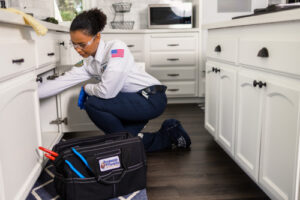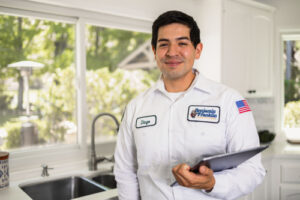Professional Drain Cleaning: What Really Happens When the Pros Show  Up
Up
Ever had that moment of truth when you’re standing over your sink, empty bottle of drain cleaner in hand, watching the water still pool instead of drain? Yeah, me too. That’s usually when reality hits—your drains need more help than what comes in a plastic bottle from the hardware store.
I’ve seen everything from hair clogs that could pass for small animals to kitchen pipes so coated with grease they were practically closed shut. Professional drain cleaning isn’t some mysterious process it’s actually a systematic approach using specialized tools that most homeowners simply don’t have access to. Let me walk you through what really happens when you call in the experts.
When DIY Just Isn’t Cutting It Anymore
Before we dive into the process, how do you know when it’s time to wave the white flag and call for reinforcements?
Here are the telltale signs I’ve learned to watch for:
Slow Drain When your sink or shower starts draining like it’s taking its sweet time, that’s usually the first warning. Water shouldn’t stand around contemplating life before it goes down the drain.
The “Didn’t I Just Fix This?” Syndrome If you’re on a first-name basis with your plunger and use it more often than your coffee maker, you’ve got a recurring problem that needs proper attention.
Symphony of Strange Sounds Those gurgling noises coming from your drains aren’t normal. When your bathroom sink gurgles while you’re running the dishwasher, your pipes are basically sending an SOS.
Mystery Smell Let’s be honest drains shouldn’t have their own distinctive aroma. If there’s a funky smell wafting up from your sink or shower, something’s decomposing in there, and it’s not getting better on its own.
Standing Water When water backs up in your tub while the washing machine runs, or your sink fills up when you flush the toilet, you’ve got bigger issues in your main line.
The Failed Home Remedy Marathon If you’ve tried hot water flushes, baking soda volcanoes, and store-bought chemicals with no lasting improvement, it’s time to stop throwing solutions at the wall and call someone who knows exactly what’s happening in those pipes.
What Really Happens During Professional Drain Cleaning
When a professional plumber arrives to tackle your drain issues, they’re bringing more than just a fancy plunger. Here’s the step-by-step process most don’t get to see:
1. The Detective Work
Good plumbers start by asking questions: Which drains are affected? How long has this been happening? What have you already tried? This isn’t small talk—they’re narrowing down potential causes before they even look at your pipes.
I remember one job where the homeowner was focused on their bathroom sink, but my questions revealed they were also having issues with their washing machine drain. That connection helped identify a main line issue instead of just a localized clog.
2. The Inspection Phase
This is where things get interesting. While you might be able to see that water isn’t draining, professionals can actually see why. Many use drain cameras—specialized waterproof video equipment that travels through your pipes and transmits real-time footage.
These cameras reveal exactly what’s happening: Is it a localized hairball? A grease buildup? Tree roots invading the line? A pipe that’s sagging or damaged? This visual inspection takes the guesswork out of the equation and helps determine the best cleaning method.
3. The Right Tool for the Job
Once they know what they’re dealing with, professionals select from several specialized approaches:
Drain Snaking (Augering) This involves a flexible metal cable with an auger or corkscrew tip that’s fed into the drain. As it’s pushed through, it either breaks up the clog, grabs it for removal, or pushes it through to where the pipe widens. It’s effective for localized blockages like hair clogs or small objects.
Hydro Jetting Think of this as power washing for your pipes. A high-pressure stream of water—up to 4000 PSI—blasts away years of buildup on pipe walls. Unlike snaking, which creates a hole through a clog, hydro jetting scours the entire pipe clean. It’s especially effective for grease, sludge, soap scum, and even small root intrusions.
Rooter Service When tree roots have found their way into your sewer line (they’re attracted to the water and nutrients), specialized cutting heads can cut through them while leaving your pipes intact. This is often followed by hydro jetting to clear out the debris.
4. The Proof Is in the Flow
After cleaning, a good plumber will run water through the system to verify everything’s flowing properly. They might even use the camera again to show you the before-and-after difference in your pipes. This testing ensures the problem is actually solved—not just temporarily improved.
5. The Prevention Plan
The best professionals don’t just fix the immediate problem; they help you prevent future issues.
They might recommend:
- Installing drain screens to catch hair and food particles
- Regular maintenance cleanings if you have recurring issues
- Trimming trees whose roots are threatening your sewer line
- Changing certain habits that contribute to clogs
Common Questions About Professional Drain Cleaning
How long will this actually take?
Most standard Professional drain cleanings take 1-2 hours from arrival to completion. Main line clogs or more complex situations might take longer, but a professional should be able to give you a reasonable estimate after their initial assessment.
Is hydro jetting safe for all pipes?
Not necessarily. While it’s incredibly effective, hydro jetting might be too powerful for very old, fragile, or already damaged pipes. That’s why the inspection phase is so important—professionals need to assess your specific plumbing before deciding on the best approach.
Why shouldn’t I just keep using liquid drain cleaners?
Chemical drain cleaners provide temporary relief at best, and at worst, they can damage your pipes over time. They eat away at clogs but also at your plumbing. Plus, they’re typically harsh on the environment.
Do I need this done regularly, or just when there’s a problem?
It depends on your situation. Homes with lots of trees near the sewer line, older plumbing systems, or a history of recurring clogs often benefit from scheduled maintenance cleanings—usually annually. For others, calling when you notice slow drains is sufficient.
The Bottom Line on Professional Drain Cleaning
Professional drain cleaning isn’t just about clearing a clog—it’s about restoring proper function to your entire plumbing system. When done right, it addresses the root cause of your drainage issues rather than just the symptoms.
Next time your drains start slowing down, remember that what’s happening in your pipes is probably more complex than what you can see from above. Sometimes the smartest DIY decision is knowing when to call someone with the right tools, experience, and expertise to solve the problem for good. Because nobody wants to keep buying drain cleaner every month for the same recurring problem.

